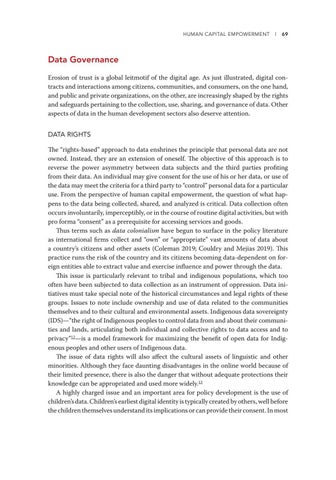Human Capital Empowerment l 69
Data Governance Erosion of trust is a global leitmotif of the digital age. As just illustrated, digital contracts and interactions among citizens, communities, and consumers, on the one hand, and public and private organizations, on the other, are increasingly shaped by the rights and safeguards pertaining to the collection, use, sharing, and governance of data. Other aspects of data in the human development sectors also deserve attention. DATA RIGHTS The “rights-based” approach to data enshrines the principle that personal data are not owned. Instead, they are an extension of oneself. The objective of this approach is to reverse the power asymmetry between data subjects and the third parties profiting from their data. An individual may give consent for the use of his or her data, or use of the data may meet the criteria for a third party to “control” personal data for a particular use. From the perspective of human capital empowerment, the question of what happens to the data being collected, shared, and analyzed is critical. Data collection often occurs involuntarily, imperceptibly, or in the course of routine digital activities, but with pro forma “consent” as a prerequisite for accessing services and goods. Thus terms such as data colonialism have begun to surface in the policy literature as international firms collect and “own” or “appropriate” vast amounts of data about a country’s citizens and other assets (Coleman 2019; Couldry and Mejias 2019). This practice runs the risk of the country and its citizens becoming data-dependent on foreign entities able to extract value and exercise influence and power through the data. This issue is particularly relevant to tribal and indigenous populations, which too often have been subjected to data collection as an instrument of oppression. Data initiatives must take special note of the historical circumstances and legal rights of these groups. Issues to note include ownership and use of data related to the communities themselves and to their cultural and environmental assets. Indigenous data sovereignty (IDS)—“the right of Indigenous peoples to control data from and about their communities and lands, articulating both individual and collective rights to data access and to privacy”12—is a model framework for maximizing the benefit of open data for Indigenous peoples and other users of Indigenous data. The issue of data rights will also affect the cultural assets of linguistic and other minorities. Although they face daunting disadvantages in the online world because of their limited presence, there is also the danger that without adequate protections their knowledge can be appropriated and used more widely.13 A highly charged issue and an important area for policy development is the use of children’s data. Children’s earliest digital identity is typically created by others, well before the children themselves understand its implications or can provide their consent. In most

